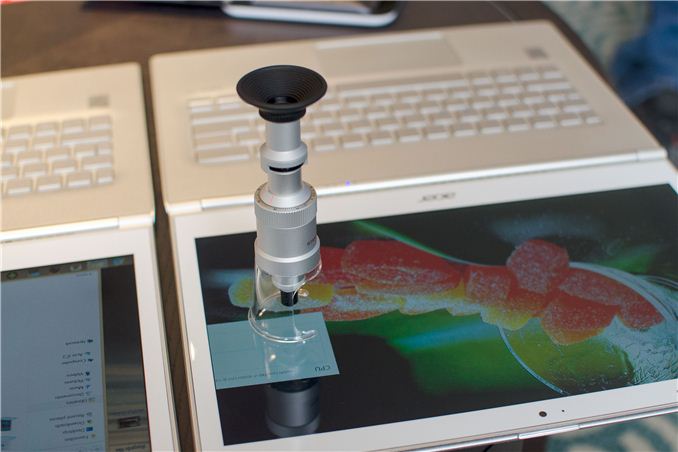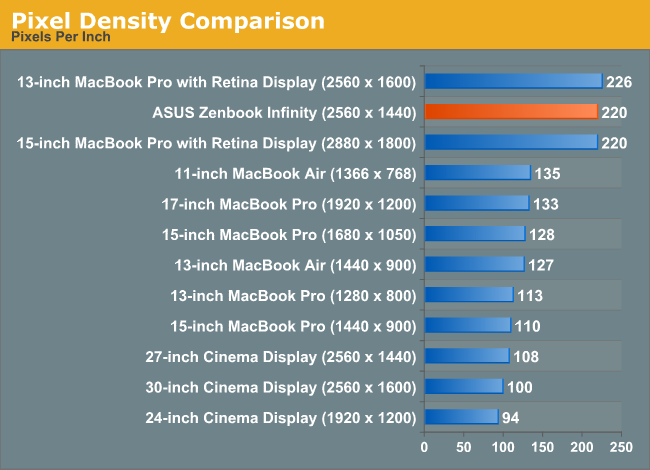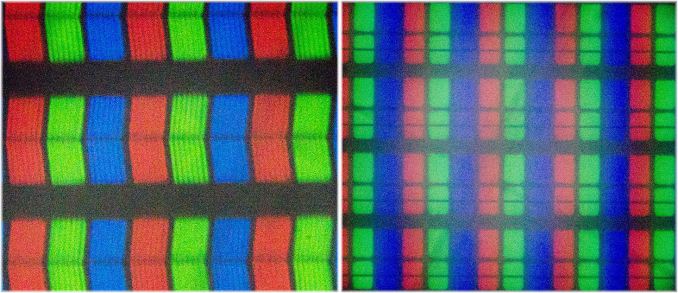Up Close with the 13.3-inch 2560 x 1440 Panel on Next-Gen Ultrabooks
by Anand Lal Shimpi on June 6, 2013 9:05 PM EST
Although entry level PC notebooks will still ship with a 1366 x 768 panel, the high end of the market is quickly shifting to 1080p and higher resolution panels. Some of the most interesting notebooks at Computex launched with high DPI panels, such as the new Acer Aspire S7 and the ASUS Zenbook Infinity - both with 13.3" 2560 x 1440 displays. These displays offer comparable pixel density to Apple's MacBook Pro with Retina Display.

Intel had one of the 2560 x 1440 Aspire S7s at their Computex suite as well as a microscope for showing off the difference in pixel size. With a 33% increase in pixel density, the 2560 x 1440 panel obviously has smaller pixels.
There's nothing new about increasing pixel density, however OS support/integration is just as important to the overall experience as physically outfitting notebooks with high DPI panels. Windows has traditionally done a terrible job of DPI scaling on the desktop, but word around Computex is that this should be fixed with Windows 8.1.











38 Comments
View All Comments
piroroadkill - Friday, June 7, 2013 - link
Good comment. Chromebook Pixel has the best screen of the lot. A refreshing taller ratio. 16:9 on PCs needs to be sidelined.Vi0cT - Thursday, June 6, 2013 - link
Hey it's me or no one here is going to talk about the Fujitsu Lifebook UH90? it got a 3200 x 1800 14" display.piroroadkill - Friday, June 7, 2013 - link
You're right, damn, that's one hell of a resolution..Taracta - Friday, June 7, 2013 - link
Anand, do you ever look at these magnified images of the screen and say to yourself that they could make even higher PPI/DPI screens but they are choosing not to? Well we know that they can have it up in the 400s but I believe that they have the capability to go even much higher but are choosing not to. Just thinking about Moores law and how it would have applied to LCDs. Over a decade ago we had at the cutting edge 200 PPI/DPI 22" LCDs, now we are barely over 100! Ridiculous!MrSpadge - Friday, June 7, 2013 - link
400+ ppi? Increasig cost and power consumption for no good reason other than "to have the higher pixels"? Yay, sign me up!Taracta - Friday, June 7, 2013 - link
You do realize that those 400+ PPI/DPI screens are used on cell phones where power consumption is a very important consideration so why would it all of a sudden start consuming lots of power when scaled up to 20+"? As for cost, if they already have to technology to build 400+ PPI/DPI screens most to the cost are already sunk so only the up-scaling cost is left for the manufacturer.The only "cost" is to us, the consumers, who are being suckered into believing that the exorbitant cost they are going to try selling this technology at is justified because “they have to keep the runaway power consumption down and it’s expensive to do.” I hope there are more companies like Seiki to burst the bubble.
Azurael - Friday, June 7, 2013 - link
I can't see the difference between a 720p 4.7" screen and a 1080p one, to be honest. It's all marketing. Well, on LCDs anyway. On OLEDs, the shrunken subpixels means they finally don't look jarringly horrid.roltzje - Wednesday, June 12, 2013 - link
I plan on getting a 1080p 12-13" touchscreen for my next laptop.. praying that 8.1 fixes the scaling issues!